Eggs, eyes and quantum - November QnA
This week - How do glow worms glow, and can they do so indefinitely? Why don’t birds fall out of trees when they sleep? And space tourism: when can I book my ticket to orbit? We've assembled an expert panel to answer your science questions - Richard Hollingham, space and science journalist; Keziah Latham, optometrist; Peter Cowley, tech investor, and Sophie Mowles, behavioural ecologist.
In this episode

00:51 - Emu eggs, vision aids and bed bugs
Emu eggs, vision aids and bed bugs
Richard Hollingham, Space Boffins; Keziah Latham, ARU; Peter Cowley
Our experts - Richard Hollingham, space and science journalist; Keziah Latham, optometrist; Peter Cowley, tech investor, and Sophie Mowles, behavioural ecologist - brought along some show and tell items to show us...
Chris Smith - And let me introduce you to the panel who are going to help me answer your science questions this week, Richard Hollingham is an award winning space and science journalist. He also makes the 'space boffins podcast' has been going a while now.
Richard Hollingham - Must be! Yes. It is eight years more than eight years. Yeah I know one of the one of after your podcast of course we're one of the early podcasts and now everyone's doing it.
Chris Smith - Yeah it's going strong.
Richard Hollingham - It is. It's still going very strong. Yeah.
Chris Smith - And what have you brought for us to get you fired up in the space realm?
Richard Hollingham - I've brought some show and tell it's in a plastic bag so you can hear. This is from 1954 "The Boys' Book of Space", only for boys.
Chris Smith - Where do you get that?
Richard Hollingham - Patrick Moore! I bought it from a charity shop in Norwich. It talks about and it goes through all the science, everything we know about the moon and Mars and actually what's interesting is there's a section at the end, it's got some beautiful pictures of retro rockets. It's in 1954, so before there were rockets, we had the V2 rocket, we had other rockets but no one to put anything into orbit yet - so the first satellite was 1957.
Chris Smith - Well I love looking at things like that to see what people's predictions were. Star Trek, if you look at Star Trek I mean it wasn't Patrick Moore's book obviously but it made interesting predictions about where we would be with tech by 'X' years and much of it's come to pass. What does Patrick Moore's say?
Richard Hollingham - Yeah well that's really interesting. So he says the first true spaceflight will take place sometime between 1980 and 1990. So way off then! So we are the first satellite 57, first man in space 1961, man on the moon 1969, but some things are pretty much spot on and the space station will be fully planned by 1995, and its construction will start between 2000 and 2020. So we know we have now the International Space Station, right now there are six people on the space station, it's been continuously occupied since the year 2000. So actually space station was pretty much spot on, first lunar voyage by 2020. Well we've had that 69 but we're going back by 2024 and first expedition to Mars will set off around 2050. He is probably right.
Chris Smith - He's a visionary.
Richard Hollingham - He is. He's probably still right, The Boys' Book of Space.
Chris Smith - And talking of being visionary sitting next to Richard, Keziah Latham is a vision specialist she's at Anglia Ruskin University, so horrible pun but what's caught your eye?
Keziah Latham - Well thank you much. What I have brought with me, to follow on from the space theme, I've brought some low vision aids and the first one I've brought is actually a telescope. But this is not the sort of telescope that you would use for looking at the stars. You could, but it's a low vision aid to help somebody who doesn't have terribly good vision, to magnify things in the distance.
Chris Smith - It looks like a pair of glasses wearing a pair of glasses.
Keziah Latham - It does look exactly like that. So you've got a spectacle frame, it's got a lens at the back and then actually with all the telescope is two lenses separated by a gap of air and that's exactly what we've got here so we've got a rear most lens and then a gap of air and two lenses sticking off up at the front like sort of bug eyes and we can adjust the position of the gap between those two lenses, and that will give you a magnified view of something in the distance, be it stars or be it the television.
Chris Smith - So who would benefit from that chiefly?
Keziah Latham - Pretty much anybody who has got a loss of vision that means they can't see the things they would want to do in the distance, we use a lot of techniques to magnify things to compensate for that. So the second thing I've brought is something that would magnify things for closer work and this is just a positive lens, it looks a bit like a paperweight, a sort of a slice out of a paperweight, with a battery pack on the back. So the idea is that it's a curved lens, it's a positive lens which is going to create a magnified image, we've also got a nice light that shines into it, and once the light is on, it bounces around inside the lens so that we really brighten up the image that we've got there - we also get some magnification out of it. So we make things bigger and brighter and a lot easier to see for somebody who's got vision loss.
Chris Smith - Thanks Keziah. Now also here is Sophie Mowles, she's also at Anglia Ruskin she's been on the programme before. Now you wouldn't show us what you're what you've snuck into the studio. So everyone is eager to see what it is you've got.
Sophie Mowles - I've kept it a secret until now I've hidden in my hat and I have this.
Chris Smith - Looks like an enormous egg!
Sophie Mowles - It is indeed. It is an enormous egg. Now this is an egg of an emu. So I've brought this back from when I was working in Australia, they farm them there, it's all ethical and it's been blown - so this is as it would be. But what's really interesting about it is the colour, now it's faded a bit, I used to have it in a stand so you can see the original colour there, and it's a very dark greeny black. Now there are two pigments that are making that up but the reason being it's camouflage. So they have male parental care and allows the male to go away from the nest and he can leave the eggs so nicely camouflaged. Ostriches have big white eggs because they're in very very hot places and being a white egg it's obvious to predators but it does reflect a lot of the heat. So that's stopping the egg from getting scrambled. But it's really cool and why I wanted to bring this in is because it's so different is that a couple of years ago, some dinosaur eggs were discovered with the same pigment in. Which indicates that they had the same parental care mechanism and it's probably male parental care there too. All from what we know about this!
Chris Smith - I did read from researchers also in Australia a few years ago, they were looking at birds recognising their own unique speckled pattern on their eggs being that they could then tell if say a cuckoo had come in and tried to sneak an egg into their nest and they could tell that the wrong number of spots were on the eggs for example - so that's another mechanism to avoid a different kind of predation isn't it.
Sophie Mowles - Yes cuckoos seem to be able to get past this, especially in the UK where we've got different genetic lines of cuckoos that mimic the speckled genus of different kinds of birds' eggs, for example the reed warbler. The problem is that your eggs are going to change a little bit over time again to get bits of feaces on them, bits of blood, and the speckling will change over time, so it's best not to imprint completely on them just in case you make a mistake and chuck one of your own eggs out of the nest because it looks a bit wrong now.
Chris Smith - Thanks Sophie. Next, Peter Cowley. He's a tech expert. He's also an angel investor and is invested in some 40 companies or so now.
Peter Cowley - Over 70 now.
Chis Smith - Over 70.
Peter Cowley - Of which 50 are still alive!
Chris Smith - Last time on the show you brought in a jet engine the size of a small dice that one would or di one would play a board game with. I've got lots of people were intrigued by that. What have you got for us this time?
Peter Cowley - This isn't the same at all. I was with a BBC film crew on Friday here in Cambridge, where we were filming how angel investors operate to try and disprove that Dragons' Den is the way that we live - which it certainly isn't. I went to see a company that I am a shareholder in and a director of, which has a device that detects bedbugs. So I have some bedbugs here - they are dead! They're surprisingly big actually. They're about the size of very small lady birds and the device itself is here. The reason this was set up was a couple of guys here from Cambridge University who are in the 30s actually and one of them had a big problem with bedbugs, so they've decided to go for pest detection. So not specific to bedbugs they're also working on some forestry pests up in Scotland, and the device itself is different from the competition in that it's long battery life, very low power. So the bedbugs are attracted by a lure, which is made up of dead bed bugs. At the moment it is made up of dead bed bugs, in time it'll be some sort of chemical formula. There's a little camera and the hardware in here has to be as low power as possible, so it has a look and sort of thinks this might be a bedbug rather than a spider or anything else, and if it thinks it is it sends it up to the cloud where some machine learning.
Chris Smith - Should be clear the image goes to the cloud, not the bedbug! That happens later once the bedbug is dead...
Peter Cowley - Exactly wherever bed bugs go! And so that goes to the cloud, checks whether it is a bedbug, and then emails the hotel, usually the hotel it could be a hospital, running a report saying that room 17 has a bedbug. The point is of course is to get them earlier before they multiply before and start biting the humans.
Chris Smith - Does it kill the bedbug in the process?
Peter Cowley - It has some technology in that to do that, but that's not the point at the moment, the point is to make sure it is a bedbug, and get in quick because you can't kill all of them.
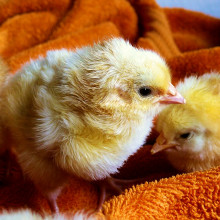
13:29 - Does a double-egg yoke make two chicks?
Does a double-egg yoke make two chicks?
Patricia called in to ask "if you have an egg with two yolks in it, will you get two chicks if it's fertilised?" Animal expert Sophie Mowles from ARU gave the answer...
Sophie Mowles - No unfortunately not. Well actually very happily for the chicks. So what's happening there? You usually get double yolk eggs from chickens, when they are new to laying and it's a mistake that they've made so they've overprovisioned an egg. They're often in very small eggs as well they're coming from pullets. So when the chicken makes the egg they're creating this yolk that's going to be all of this money it's full of fat and resources that's going to allow the developing embryo to grow. Now it's a mistake that they've made because they're not used to that process yet, and they've overinvested in the egg, but when the egg is working its way down her tract, it will be fertilized by one sperm from the rooster. So you would not get two embryos.
Chris Smith - So they're not two 'fertilizerable' sort of precursors in there in the same way, as a human egg could actually split and make two or you could have two human eggs and get two sperms and therefore have two non identical twins in that case you can't do the same with a chicken egg, you can't split the embryo into two and end up with two developing chicken eggs in an egg.
Sophie Mowles - I'm fairly sure you can't. I've never known this to happen in birds. However, in reptiles these sort of mistakes do seem to happen and this is why you seem to have a lot of very strange photos occurring of double headed snakes, two headed turtles, it seems to happen more often than would be predicted by chance. I mean, it is a chance event and so it seems to be that you can create twins in reptiles but not in birds
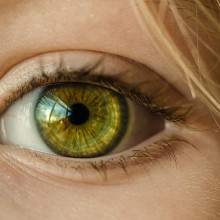
What do blind people "see"?
Optometrist Keziah Latham from ARU took on this question...
Keziah Latham - I think that is a very good question and the short answer is, it depends on the blind person, but probably more than you might imagine.
Of the people in the UK who are registered blind, about 95 percent of them can see something - some level of light and dark. About 75 percent people who are registered blind can read newspaper headlines. So most people have got some level of residual vision and, in fact, we no longer talk about people being registered blind, but we call it severely sight impaired these days because that's a lot more representative of what people actually see. But then what somebody actually sees kind of depends predominantly on the reason for their visual loss and it can be quite different depending on different eye conditions. So if you take something like macular degeneration, which is the most common cause of visual loss in the UK, that damages vision in the centre. So in the middle of your vision the area called the "macula" in the retina, which does the vision which is the bit that you're looking at when you look directly at something.
Chris Smith - So when I'm looking you in the eye, that's my macula doing that?
Kezaih Latham - That is the macula.
Chris Smith - So, if I had macular degeneration right now, I would look at you but what I would see is the rest of the room at lower acuity, because it's the rest of the room, but the bit where I would expect to see the most detail would be either blurry or - at worst case scenario - I just see a black patch?
Keziah Latham - Yeah.
Chris Smith - No face.
Keziah Latham - You tend not to see a black patch of sorts. That tends to be something that gets put in pictures of "this is what macular degeneration looks like". It tends not to be actually; when you actually ask people they'll say that things are kind of missing or blurred. The brain's brilliant at "filling in". So if you have got this damaged area in the centre, mostly what will happen is that that bit in the middle will be kind of filled in to sort of match the surrounding bit that is still working. And so with macular degeneration, people have still got peripheral vision - it's very, very, rare that somebody would lose their vision altogether - but that central part of vision that you would use for recognising faces, for reading that kind of thing - that would be the bit that was most impaired.
But then on the counter side to that, you've got other conditions like retinitis pigmentosa, which is an inherited retinal disorder. So that affects the receptors at the back of the eye as well, but that predominantly affects peripheral vision. So that means that somebody tends to with that kind of condition tends to lose their peripheral vision but retain their central vision. So that's a little bit like looking through a tunnel. So you can see straight ahead, but everything off to the sides has disappeared. So that makes things like mobility and getting around finding out where you are and how to get to somewhere very difficult, but it still leaves somebody with enough central vision to maybe be able to read or use their phone. So there have been some instances recently where people have got into trouble, if you like, in that they're out and about with their white cane or their guide dog and somebody spots them using a phone and goes "you're cheating! You're not blind!" - but that's complete nonsense. You try living with only your central vision and no peripheral vision and you will find that although - yes - you can use your phone, you are still very visually impaired by that.

18:42 - When will quantum computers be in our pockets?
When will quantum computers be in our pockets?
Tech expert Peter Cowley took on this question...
"Quantum computing is here! But when might we have quantum computers in our pockets, or on our desktops?" Tech expert Peter Cowley took on this question...
Peter Cowley - Yes. Okay. Well, quantum computing hit the headlines in the last week or so because Google came up with a new version called 'Sycamore', which was 53 cubits. Very briefly - and non-technically - a "bit" normally is 0 or 1. A "cubit" - a quantum bit - can have multiple states. So say it has a thousand, which is the number they're talking about, two together there's a million, whereas two digital bits only has four states. So Google has created this thing which they claim will do a calculation that takes 200 seconds, which would normally take 10000 years - so that's pretty quick!
IBM came back and said, look we've got a quantum computer and we don't agree with this and we think that you actually should be comparing 200 seconds with two and a half days. Still a big difference. The point is what this quantum computer looks like - and there are some pictures on the Internet - basically it runs at one 15000th of a degree above absolute zero. That's not going to be easy to get in your pocket! So 15 millikelvin! There's also a few other problems: the cubit itself, if you've got a nought or a one in your hard disk or on your mobile phone, you want it to stay there. The decay time of cubit is 10 microseconds, so it needs refreshing quite quickly. It also randomly will change state in a way that don't really understand yet. So you need a lot of error correction. So they're saying that it'll take about 10 years before you get a big enough quantum computer in the lab to actually do something, and that's going to be running at basically absolute zero, and it's going to take a lot of energy. So I have no clue how long before it gets into our pockets!
Chris Smith - Richard...
Richard Hollingham - Well I just have a question about this. Is there competition. You mentioned IBM and Google, because a lot of these things - I mean, I was talking about space and the space race - a lot of these things happen when you've got competition - people competing - and suddenly things get faster and faster.
Peter Cowley - You can buy a quantum computer from a company in Canada actually, I've forgotten the name now, but only a few bits long. The point is that it is it's sort of on the hype curve at the moment. It's going up there, if anyone knows about the Gartner hype curve - there's no doubt it will be of use. They say, for instance, that a quantum computer will be hard to crack any cryptology in the world instantaneously. That means nothing is secret any longer anyway. Now, of course, people are working on stopping that happening in all kinds of different ways. It's a very long way from any form of commercial use, but, yeah, competition does help...
Chris Smith - Peter thank you very much indeed.

23:09 - How long do glow worms glow for?
How long do glow worms glow for?
Animal expert Sophie Mowles from ARU took on this question from NeilEP on our forum...
Sophie Mowles - Okay. Glow worms are really interesting! They're actually a beetle and we get them in the UK and it's the female that does the glowing. So she doesn't transform in a typical way into an adult; she looks a lot like a larva but a heavily armed sort of "trilobite-type" creature about two and a half centimetres long, and she produces a glow. The male looks like a typical beetle and he's attracted to her so he'll fly through the night and and be drawn in by her glow.
Now, she produces a chemical called luciferin, which is fantastic: in reaction with oxygen, this produces a glow - so what we call 'bioluminescence' - biologically produced light.
Glow worms don't actually feed as an adult, so they metamorphose into that adult form and they don't have mouth parts. They do not need to eat at this point, all they need to do is find a mate, and mate with one another. So she's kind of stuck, she's relying on reserves that she's built up as a larva; she lived for about two years as a larva actually, eating, to make sure she's got enough reserves to produce this chemical reaction. Once she's mated, that's it - that's all she needed. So she will use his sperm and fertilise her eggs and she will stop glowing she doesn't need to anymore.
She will hopefully find a mate; if not, she might run out of energy and she might have to stop glowing. But the males, back on the subject of eggs, they really like females that are glowing strongly, because they're big they contain lots of eggs! So he's going to get lots and lots of offspring!
Chris Smith - and that's a sign if they if they can afford to glow very brightly they're well-fed: lots of energy, probably a healthy female isn't it more likely to have healthy offspring?
Sophie Mowles - Indeed, and also generally a bit larger. So her - what they call the lantern, which is the section of her abdomen that glows - will be bigger on a bigger female, and bigger female, bigger body, lots of eggs. So the males like that!
Chis Smith - Thank you very much Sophie. So there we go shedding some light on how glow worms ones work!

25:17 - How fast a rocket can humans safely travel in?
How fast a rocket can humans safely travel in?
"How fast a rocket can humans safely travel in?" Space science journalist Richard Hollingham answered this question for us...
Richard Hollingham - Okay. That's the wrong question! I'll come on to why it's the wrong question a second. We're actually travelling very fast right now; so I had to write these down, because I had to work some of these out as well so they might not be wholly accurate. So the Earth rotates at 600 miles an hour. So we're currently on the earth going 600 miles an hour, because we're on the earth we're also going 600 miles an hour. The Earth is speeding around the sun at 70,000 miles per hour. So we are also speeding around the sun at 70,000 miles an hour. The sun is speeding through the galaxy at 450,000 miles an hour, which means we're also spinning at 450,000 miles an hour. So, actually, we can go very very fast! The proper question is what acceleration can a human stand?
That's when you come into g-forces, and the idea of the amount times gravity that you can you can withstand. So, typically, a rocket, something like the Soyuz rocket, which is what astronauts use to get to the International Space Station, doesn't actually accelerate that much it's about 3 or 4g - if that - maximum going up to the space station. Coming back, it's more unpleasant: it's kind of nearer 5g, but not for a long period of time, so that's fine. We know from experiments done in the 1950s by Colonel John Stapp - a military doctor, who did experiments on himself, as all good doctors should do, he attached himself to a rocket-powered sled. And sped along this track and then braked very sharply to see what g-forces pilots could endure. The most he went up to was - and bursting the blood vessels in his eyes in the process but actually suffering no serious injury other than that - was 20g.
Chris Smith - Did he decelerate with his head towards the direction of travel, or away? Because this makes a difference because it makes a difference whether the blood goes away from your brain and you get 'blackout', or towards your brain and you get so-called 'red-out'?
Richard Hollingham - Interesting. He was on a chair on a sled. I guess, the acceleration would be going through his chest - through his body - the same way as astronauts. It's the reason they lie down on couches so that the acceleration - so that the forces - are going through your body rather than straight down through your head, which is something you want to avoid. So yes, you get this idea of blackouts and astronauts also wear to avoid that - and pilots do too - they have a far greater g-forces so they wear pressure suits and they will push the blood towards the head so you don't blackout. You don't want to be unconscious when you are flying a jet fighter!
Chris Smith - So returning to the question, which was what's the best sort of rocket to go in terms of speed, actually, that doesn't matter: it's the acceleration that matters and the acceleration is what determines the g you're going to feel. So what would be a comfortable g for a human to feel? I mean, when I'm taking off on an aeoroplane, what sort of g-forces are they?
Richard Hollingham - Nothing!
Chris Smith - So that's what I want. So basically yeah.
Richard Hollingham - Actually, the best spacecraft for comfort was absolutely the space shuttle. Not too bad on the way up, and coming down it sort of circled: it looped and looped, to lose energy as it came down to Earth, and as it did that it was quite a gradual deceleration; whereas the 'Soyuz' again g-forces going up not too bad, coming back is pretty horrendous. I've heard it described as like going over Niagara Falls in a barrel - but a barrel that's on fire!

30:38 - Americium and dilithium - it's quiz time
Americium and dilithium - it's quiz time
Peter Cowley; Keziah Latham, ARU; Richard Hollingham, Space Boffins, Sophie Mowles, ARU
We put our experts - Richard Hollingham, Keziah Latham, Peter Cowley and Sophie Mowles - to the test with our Naked Scientists quiz...
Chris - Now every time we do one of these programs we have a little quiz and this is where rather than you sending in the questions, I've written some questions and you have the chance to enjoy them as well at home, but our panel will have their mettle tested. Now our two teams are going to be Richard and Kez, they are team one, and Peter and Sophie, you're going to be team two.Now round one is called step back in time. So team one, which scientific invention that we all know and love was patented first? Was it the fridge or was it Edison's light bulb? What do you think Richard and Kez?
Richard - Oh I would say fridge, well I would guess the fridge.
Keziah - I'm thinking it's probably going to be a trick question because it feels like it ought to be the light bulb, so that might make it the fridge.
Richard - because I would say yeah, I think the fridge.
Keziah - Yeah but obviously not a fridge with a light in it.
Chris - Yeah. You get the ping for that. Indeed it is. According to livescience dot.com, Edison patented the first commercially successful light bulb in 1879 but the first fridge which had a vapor compression refrigeration cycle that used liquid ammonia was patented in 1835 by Jacob Perkins. Okay, Peter, it's over to you and Sophie now. Which discovery came first - Volta’s battery or Edward Jenner’s smallpox vaccine? What do you reckon?
Peter - So smallpox, when was that 1830’s?
Sophie - I think so, yes.
Peter - Yeah, 1840s? and Volta’s battery feels like it's older than that, but you know.
Sophie - I think it would be a guess from me.
Peter - Yes. What do you want to guess then?
Sophie - Oh crikey. Shall we go for smallpox?
Chris - What are you going for? Are you going for the vaccine or are you going for the battery?
Peter - I think we're disagreeing here so, shall we toss a coin? We go with Sophie. Sophie went first. Yep.
Sophie - Smallpox.
Chris - You’re going vaccine? Well good call. It is indeed the vaccine. Alessandro Volta, who is credited with inventing the first battery, he used zinc and silver in his battery - very expensive, gave a demonstration of his batteries generation of electric current in front of Napoleon in 1801. But, it was in 1796 that Edward Jenner introduced the smallpox vaccine from which the first commercial, well you know commercialized vaccines, after that were invented.
There you go, well done. It's one-all, level pegging. Okay onto round two. Round two is called “Elementary”. “Elementary” and we need you to tell us, Richard and Kez, which of these radioactive elements isn't man made. Okay, Americium, Curium or plutonium. What do you think it is?
Richard - Plutonium. Oh no, because you have to make plutonium don't you?
Kez - Curium has got to be made by curing.
Richard - Yes.
Kez - So I'm guessing not that one.
Richard - and Americium I think was made, im guessing, in America. Yes I would go for plutonium.
Kez - Yeah let's go with that.
Chris - You're on fire. Americium and Curium are produced by smashing neutrons into plutonium - you need a reactor to do that. Now plutonium can be made artificially, but trace amounts of it do occur naturally so good call, well done to you. Right, Peter and Sophie, which one, also elementary speaking, which one of the following aren't elements that you would find in the periodic table? No cheating by the way, no looking up the periodic table. Here are your three elements - Didymium, Di-Lithium or Di-Nitrogen.
Peter - It's not in the periodic table.
Sophie - It’s not dilithium, that's from Star Trek. I hope that no one has found one and made it.
Chris - We're going dilithium?
Sophie - Yes.
Chris - Dilithium. Actually, it’s a pretty horrible question. Okay. Dilithium, you can make molecules of Di-Lithium - just take two lithium atoms and join them together and are commonly occurring. Di-Nitrogen the same, N2, and you just take two nitrogen atoms and they form a triple covalent bond. Didymium was on Mendeleev’s periodic table in the early days. They used to think it was one element but we now realize that in fact, it's the combination of two rare earth metals which is praseodymium and neodymium and we can separate them apart. So Didymium no longer exists in the modern periodic table. So I'm afraid it's nul points for that one. Okay, so round three here we go. Now this is pretty hard. We're going to see what you make of this. Okay, these are riddles and you've got to solve this. This round is called solve this. Listen very carefully, you can take notes Richard and Kez, you might need to. Okay but I'm going to be strict about the time because we don't have too long to answer this. You are on a forested island. It is 500 meters north to south and three kilometers east to west. It is surrounded by high cliffs and ocean. A wind blows constantly across the island from west to east at a constant speed. On Monday at noon the entire western edge of the island forest catches fire. Fanned by the wind, the flames are moving at 100 metres an hour across the island. If you're trapped by the fire you're going to die. You can't jump off the island. With you is a rucksack which has got a penknife, a compass, a calculator and there's a Bible in there for good measure. How do you survive until rescue arrives on Wednesday?
Kez - Oh good grief.
Richard - On no, really, I can't. You know, I was on University Challenge once and I cannot process this sort of information quickly enough. You know, if you gave me a couple of days I'd come back to you with a proper answer. Can we just run and jump in the sea or something?
Kez - No, we can't. We can't do that.
Richard - Okay.
Chris - While you're contemplating that I'm going to come to the other team, and I'm gonna give you your one to think about too, because you can have some extra time to think, then. So team two, Sophie and Peter: A woman has a bucket of water in her hands. She turns it upside down but the bucket stays full. There's no lid on the bucket and the water is in liquid form. She's not relying on centrifugal force. How does this happen? That's your question.
Peter - So it’s obviously not frozen. There’s no lid. She’s not spinning it.. upside down… is she in space?
Chris - Have you solved it yet, Richard and Kez?.
Richard - I think Kez has a better idea about that.
Chris - So Kez, what do you reckon?
Kez - I think we've got to use the.. if we head for the eastern most side of the island, the wind, the flames will catch up with us. So, I'm wondering what will happen if we go to the northernmost or southernmost point of the island. Will we escape the flames if they're just zooming across the middle of the island to the other side? But I suspect not…
Chris - It's a good try. I'm afraid that you're not going to have that. Here's the answer. Okay, you take a little piece of wood from the fire that's currently burning. You hasten across to the other side of the island and come a hundred yards inland and light another fire. You then retreat into the forest while it burns towards the edge of the island and burns out that bit of forest. Meanwhile the other fire hasn’t arrived yet. You then go into the burnt out bit because you've created a firebreak, and you sit in there quite safe and eat your apple and read your Bible until rescue comes on Wednesday. So, I'm afraid, I'd liked your thinking but that wasn't the right answer. Peter and Sophie you've got a chance. Did you solve it?
Peter - Well, we think it’s a question you didn't give to Richard because he’ll right know it immediately.
Chris - You’re going to try me? We were gonna say she's in space? No, that's not the answer. No, she's not in space.
Peter - You’re giving us another guess?
Chris - You could go on then, you can have one. Go on, then.
Peter - Well, clearly it's not frozen. Upside down presumably means something. Rotating slowly is not going to work. It depends what upside down means really, doesn't it?
Sophie - It does.
Chris - Shall I put you out of your misery? I think it's gonna be.. I think you're going to win for the first time that you go. The answer is, okay, she's underwater. That's quite cool, isn't it? That's pretty clever. Okay, so yes, the lady was underwater. So well done, this week's big brains of the week: Richard and Kez. Brilliant, brilliant.
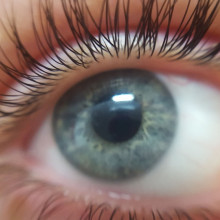
39:46 - What makes some people blink more than others?
What makes some people blink more than others?
Keziah Latham from ARU took on this question from Roy...
Keziah Latham - Okay. Well if we think of first of all about why we blink? We want to spread the tears across the surface of the eye and there's two main reasons for that.
First of all, we want a nice smooth surface at the front of the eye so that when light comes into the eye we get a nice clear image that's sent to the back of the eye. If we think about, if you look through a normal window with a nice smooth surface you can see through it. But if you look at the bathroom window which is all bumpy, you can't see through it so well. So we want a nice smooth surface from the tears. But the tears also protect the eye to a certain extent. So they move little bits of debris and dust off the eye and actually there's enzymes called lyzosyme in the tears which have got antibacterial properties as well so it sits in keeping the eye safe.
Now there's there's three types of blinking. The spontaneous blinking which is what we do automatically without thinking about it; there's reflex blinking, which is what you do automatically when there's some sort of threat to your eyes, so you want to close your eyes to protect them. And then there's voluntary blinking, where you kind of think about it. So, really, the spontaneous blinking is the one that we're interested in here and that's incredibly variable between people.
So it's completely right in the question to ask why there is this variation, and there's a whole bunch of different factors. So, to some extent it depends on the quality of the tears. So your tears are actually made up of three layers and the top layer is a fatty layer called lipid, and if you've got too much or too little lipid in your tear film, then your tears will evaporate quicker and so you'll need to blink more often to get the tears spread over the surface; and the same happens in different environments: if it's very dry, or very windy, again the tears will evaporate very quickly and so you need to blink more often. We also know that it varies with task, so if you're concentrating harder, your blink rate tends to go down and you also blink less when you're looking at computer screen, compared to looking at paper, which is quite interesting.
Chris Smith - What about lying? Because I heard that people people may just adjust their blink rate when they are telling porky pies?
Kezaih Latham - There is some suggestion that when people are concentrating harder - and lying may take more concentration - that they might that they might blink faster. Also, if you're attracted to somebody, you might blink faster as well. So there's a whole range of factors and in fact normal blink rate can be anything from four to 20 times a minute. So it's really variable depending on the person.

42:20 - Are computers getting twice as fast every year?
Are computers getting twice as fast every year?
Peter Cowley answered this question...
Peter Cowley - Now this comes from Moore, Gordon Moore, who was one of the founding co-founders of Intel a long time ago and that was true between the mid 60s and mid 70s doubling every year. Then he changed it to doubling every second year up till about 2012 and it slowed down again. And we expect this to run out in about 2025. This is speeding up. Purely because we're running out of space on the chip, so it's going down to three nanometer architectural mode which is only 15 silicon atoms across and so how do you create a transistor where you're getting down to the atomic level almost?
Chris Smith - So basically the components on the chip are getting so small now that they're it's impossible really to shrink them practically any further than we already have?
Peter Cowley - Using the technology that's based on semiconductors. Of course we might be using other forms of technology - quantum computing as we mentioned or some sort of light processing. So yeah we're running out of that. But there is a bigger problem. Just to give you an example, I brought a computer in to show a couple years ago which had 3000 transistors on which I built in 1975. There are 260 billion transistors in this phone in my hand. But again, this isn't the problem, it's not the speed of the process that really matters, unless you've got a supercomputer, because the software sits on top of it and the software is getting more and more bloated and again to give a little example here I wrote some code back in the late 70s and I spent nearly six weeks trying to remove 40 bytes, not kilobytes, or megabytes, out of this code so it would fit in a particular chip size which was two killer bytes long. So, I spent six weeks! But nowadays because memory hard disks, everything is so plentiful. software is just getting bigger, and bigger, and because of this actually the speeding up of the things isn't happening nearly as fast as the hardware is improving.
Chris Smith - I have noticed actually that I haven't had to buy a new computer for a long time. And it hasn't actually deteriorated in performance terms! What I could have replaced it with wouldn't be that much better than the computer I'd had for the last five years 10 years whatever and the thing that does shock me as you say is the software bloat, because the first computer I ever owned was a BBC model B microcomputer. It taught me to program had 32k of random access memory not 32 gigs. You know the idea of that sort of amount of memory.
Peter Cowley - Mine had 32 bytes and I'm not that much older than you.
Chris Smith - It's just amazing isn't it! The pace it moves on.
Peter Cowley - So software is the problem not the actual hardware that's building it.
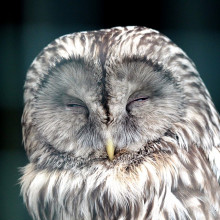
44:58 - Why don't sleeping birds fall out of trees?
Why don't sleeping birds fall out of trees?
Animal expert Sophie Mowles from ARU took on this question ...
Sophie - OK. So birds when they sleep are very vulnerable, so they've got to find somewhere very nice and safe for them to spend the night. Typically if they're a diurnal, or day-active bird, they do tend to tuck themselves up in trees, for the most part. And often they'll aggregate, so they'll join together in a big flock that will roost in a particular place overnight. And this is what we see in programs such as Autumnwatch with the big murmurations of starlings that are swooping around: they are in the process of finding a place to roost overnight. And that's typically in reed banks, so if you're in Cambridgeshire you might go out to Wicken Fen in the evening and see these flocks which will then drop into the reeds.
Another really nice example are pied wagtails, which we tend to see in ones and twos around towns, but at night they'll form big flocks and they'll roost together in safety, usually in trees that are in quite safe places. So supermarket car parks; there's a big roost at Addenbrookes hospital; and weirdly where I am - when I grew up, where I went to school - there was a roost that happened at night. And I noticed this when I was a kid, I was there late one evening - maybe for a play or something - and noticed the trees were full of these pied wagtails. They all come together. Even tree hollows, cavities, nest boxes that we put up to allow birds to build their nests and raise their young; they're a really nice, warm, safe place that birds can spend the night.
They don't fall out of the tree because of the way that their foot muscles relax. They're actually the opposite way round to how we would imagine; when bird muscles in their feet relax, they grip. So that's how they stay in the tree - they're relaxed, so they're holding on.
Chris - Do bats do something similar? Don't bats have an anatomical arrangement so that when the bat dangles upside down, as it applies force downwards on its claws, it actually encourages the foot to grip so they can hang upside down?
Sophie - I believe it's the same mechanism.
Chris - Because the one disease that bats are really terrified of is diarrhoea, isn't it, when they're in that situation.
Sophie - Of course...

47:18 - How will climate change affect tech?
How will climate change affect tech?
Tech-xpert Peter Cowley answered this one for us. First up, what's a server farm?
Peter Cowley - They're referring to the very many data centers around the world which are apparently about 7 million now. In the way that one has a single computer somewhere, they've been put together in larger and larger groups and this has been going on for many years. Once we moved away from the mainframe to a mini computer, to the P.C., the PCs were then stacked up in large volumes used by Facebook and Amazon Google and Microsoft etc. The sort of numbers involved most apparently about 2 percent of the global electricity usage is in server farms or data centers that work so there are only 10 countries that use more than this. The UK is number 11. So it's between UK and France, so this is 2 percent, so clearly it's a large usage and it's forecast to get up to 8 percent by 2030. This is all the photographs we upload on social media etc..
Chris Smith - I did read a statistic from Cisco who build all of the infrastructure that helps to run the Internet and they were suggesting that some enormous proportions like 80 percent or 90 percent of the traffic is video.
Peter Cowley - Yes, yes, exactly yes it's a huge amount of uploading YouTube videos, Netflix coming down, and all the other various TV streaming services.
Chris Smith - It does of course not include in the power calculation, I presume, when you're just looking at how much pollution is attached to the internet, you're not looking at the end user. So you're working out what the data center to have the servers whirring away is, but you're not looking at all the people who've got their computer on which is running at 300 or 400 watts of screen and base station and so on in all those houses, so there's a much bigger footprint.
Peter Cowley - And of course our mobile phones which need even though they're not actually taking anything from the mains, they are doing when they're being charged up. Then these data centers about half of what they use is for cooling. So effectively you're putting power in and it's obviously heating stuff up and it's got to cool it back down again. So what they're doing then is putting the data centers in places where they are cool so above the Arctic Circle etc. The disadvantage is that of course is you still got the heat generated and where's heat going to go? It's going to go into localized heating wherever it is which means we're going to start growing palm trees up in the north of Norway or something etc. So in the end you still got to remove that heat and the thing that is reducing that somewhat is more efficient processes, but of course there's a huge more and more demand and we're never going to catch up with that. I really don't know what we're going to do - put them in space!? But then you've still got to power them.
Chris Smith - I did suggest to a friend of mine who runs one of these companies that maybe he should relocate to a hospital, because the hospital I work in spends a fortune keeping the place very, very, warm for the elderly people and people who are unwell in the hospital and they're burning fossil fuels to do that. Hospitals often have big swimming pools, that they'd like to dump heat into to warm up, they have lots of empty buildings they'd like to heat up to make sure they're nice and warm for wards and things and they have uninterrupted power supplies. What's not to like? I think it's just a space issue but that might be one solution, Keziah?
Keziah Latham - Yeah and there are companies that produce a lot of heat in the processes they use that then use that heat to do things like growing indoor tomatoes so you could double up in terms of getting rid of that heat and produce something tasty as well.

50:46 - Who should colonise Mars?
Who should colonise Mars?
Space and science journalist Richard Hollingham answered this one...
Richard Hollingham - What an interesting question. There's the how and there's the who chooses, as well to that. So some scientists have done research on this and anthropologist in particular, Cameron Smith at Portland State University. I met him a couple of times he reckons you need 2000 people to successfully colonize. So presumably if you talk about in a hurry right we have to get off the earth after the earth has been hit by an asteroid. Let's get 2000 people to Mars so that's your starting point of around 2000 people and then it's the - well who chooses? So let's say we've got a fair and balanced system of choosing and I've been to several conferences on this and I always figured that the people who go to these interstellar conferences and are really into this stuff are exactly the people you do not want to send to Mars! Take a room like this. Okay so we've got a doctor, a biologist, investor, an optometrist. So would you take - I'm journalist and I'm also asthmatic - so I'm probably the last person you want to take - so I've gone.
Chris Smith - The journalist is out on the grounds because no one needs to know what happens on the day?
Richard Hollingham - Well this is the interesting thing actually, because if you look at this logically you say right we need we need doctors, we need plumbers, we need electricians, we need engineers, we need those basics and we need people to be fit and healthy - be a nice cross-section. Actually you probably also want to, if you've only got 2000 people you want to take Earth with you. So you want artists, you probably want musicians, artists and maybe even journalists.
Chris Smith - Lawrence Llewellyn Bowen on the set list as he's good at getting the space dome looking good.
Richard Hollingham - You want a cross-section of society, want a mix of people you can get mired in the ethics of who you take...
Chris Smith - Would you go Peter?
Peter Cowley - Well, I came on this program about two years ago and had somebody next to me, who was trying to get on that list or something. The list of 100?
Richard Hollingham - So, there'd been various Mars projects. There was this project which is now it's now gone out of business, which was you could sign up to go to Mars. All the people I met - and I can't talk about the person who was there - but all the people I met who had signed up - I thought you do not want to, you aren't the right person to go.
Chris Smith - No one wants to go to Mars really. If we're being sensible and they really were informed of the facts they would not want to go to Mars would they?
Richard Hollingham - It's a horrible place. I think that Elton John put it best "Mars ain't the place to raise the kids. It's a grim place". I suppose, if we need to send 2000 people off the planet to save humanity then that becomes the question.
Chris Smith - Would you go to Mars Keziah?
Keziah Latham - No! No I would not be hurrying to get onto that list. I think I'd prefer to be on the B arc as it were, in Douglas Adams terms.
Richard Hollingham - Yes exactly. And that's a really interesting example. So the Douglas Adams' Hitchhiker's Guide, the supposedly useless people including the telephone box sanitizers and the whole of civilisation gets wiped out by a bug that starts in the telephone box. So I mean it's of its time in the 1980s, but that is exactly right! It's very difficult to choose who you take.
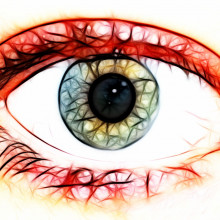
51:18 - How's focusing maintained post cataract surgery?
How's focusing maintained post cataract surgery?
ARU optometrist Keziah Latham answered this question for us...
Keziah Latham - The cataract affects the lens of the eye which sits just behind your pupil, and the lens itself is as you can imagine, a little bit like a grape. It's got a skin called a capsule and then it's full of the sort of the pulp of the grape if you like which are lens fibres. And the lens is a kind of an unusual thing in that it grows throughout life, you're continually producing new lens fibres at the edge of the lens and shoving the older fibres into the centre. Now the lens is transparent because of the regular arrangement of those fibres and we want it to be transparent so that it can let the light through to the back of the eye.
But as time goes on and you increase the number lens fibres in there, it pushes them altogether, changes the regularity, and that can lead to clouding of the lens which is a cataract. So yeah very common operation to remove that cataract. We peel away the little capsule at the front, and essentially remove all of the contents of the lens with a little sort of surgical hoover type thing and then you will put in an implant, a replacement plastic lens, to replace the power of the eye. Now, the lens in anybody under 40 or so is able to change shape a little bit, because this capsule on the outside of it is elastic, your ability to do that does decline with time. That's why we all need reading glasses by a certain age, and that again is because the lens is becoming much stiffer because it's not able to change shape as there's so many fibres in that lens.
So, by the time most people have got a cataract they're not able to change the shape of their lens anymore. So, when the lens is removed, there's a little plastic implant that is inserted kind of like a ship in a bottle into the remaining capsule of the lens. Now, in the majority of cases that is a fixed focus lens so it will be designed on the basis of measurements of the eye to give you a particular focal point, so either to be focused for distance and then you need to put reading glasses on afterwards, or possibly to set you up for reading and then you have to put distance glasses on.
Chris Smith - Can you do one of each so you can have a long one and a one short one?
Keziah Latham - So you can get around that, you can go for monovision, like that, you can do that with contact lenses as well, and give one eye distance and one eye reading.
Chris Smith - And laser? Laser correction can do that as well. You can have one eye set for close work and one for longer.
Keziah Latham - You can do and that does cover both bases, it does mess about with your binocular vision a little bit too, so it might hamper your depth perception a bit. But the other thing that you can do with intraocular lenses, the implants that get put in, is you can have multifocal intraocular lenses. Not on the NHS, but you can have multifocal lenses, and they work by diffraction so that the single piece of plastic produces two simultaneous focal points, one for distance and one for reading.
Chris Smith - Does that get light going through it in different positions according to where you're looking then? So do you have to almost learn like you do with by bifocal lenses, you have to almost learn to use them?
Keziah Latham - No it's not quite like that, where you've got sort of an area of the lens is distance and an area is reading. You have little circles engraved on the lens so that the light that falls in between the circles might be focused at one distance, say to give you distance vision, but the light that passes through the annular ridges on the lens will give you a different focal point to be focused for reading. So you get this sort of simultaneous two things in focus at once. But it can give you slightly less crisp vision, it can affect your ability to detect low contrast, so because it's trying to do a number of things at once, it's not perfect at doing all of them.
Chris Smith - So how is the fine focusing in a lens that can't change its shape achieved then? Is that purely by just moving your pupil wider and smaller in order to achieve a pinhole effect, so you can get that fine focusing and compensate that way, as you get older? Is that happens?
Keziah Latham - To some extent yes, the older pupil is a little bit smaller so you do get more of a depth of focus because if you've got a smaller aperture, you get a wider depth of focus. But the short answer is that you will get your distance correction and then you will need a separate correction for reading, you can't have both at the same time.
Chris Smith - So there'll be a sweet spot at which your vision works best and then either side of that's a compromise?
Keziah Latham - Either side of that yep but that's what specs are for!

56:04 - Will space tourism ever be affordable?
Will space tourism ever be affordable?
Space science journalist Richard Hollingham took on this question...
Richard Hollingham - I guess for the super-rich. So, currently, tickets on Virgin Galactic will set you back two hundred fifty thousand dollars. It's a bit like what Peter was talking about. It's in early stages. It's going to get cheaper. It's never going to be that cheap but it might open the door to hypersonic travel from continent to continent. So you know a trip from London to Sydney say in just just a few hours, it might kickstart that sort of economy. There are few rivals out there, but all of them are kind of around that 200,000 dollar mark. I can't see it ever coming down a huge amount, but that said I think there is one important reason why it's good that the rich and powerful can do this because there's a lot of evidence that if you see the earth from space you get this idea of the earth without borders: you can suddenly see the whole environment. Actually, if we start sending presidents and - you know - CEOs of companies up there, they might help to change the world.
Chris Smith - About two or three months ago we sent a helium balloon to the edge of space. We got to 33 kilometres and we played people's screams - listeners to The Naked Scientists - we played their screams in space; but we also put two Huawei mobile phones in the box and took beautiful shots. We were joking, saying the people in Beijing had watched the footage before we got to see it! I'm sure that's not true, but we put these mobile phones in the box and got the most gorgeous footage of the earth from 33 kilometers up, and blackness of space compared to this amazing iridescent blue, and it really does look like a marble; honestly I've watched that footage I don't know how many times and it's awe-inspiring. So I know exactly where you're coming from.
Richard Hollingham - It's what the astronauts talk about, this thin blue line separating us from the void and it is just extraordinary. I think the more people that can see that and experience for real - it will make a substantial difference.
Chris Smith - So, if Mr. Branson phones up the Space Boffins podcast and says, "Richard, would you like to go into space?" What would you say?
Richard Hollingham - I think I would have to say that yes I would love to go but if, to preserve my marriage, I would have to say my co-presenter Sue Nelson - who is also my wife - she would so much love to go to space.
Chris Smith - She's been on the Vomit Comet though! So she's got one over on you.
Richard Hollingham - You don't want to go into space, it's horrible!










Comments
Hey I love your show and have
Hey I love your show and have been listening to each episode for years now. I just wanted to make a comment on the double yolk egg question. I know for a fact, that a double yolk egg can develop two chicks. I used two grow up on a farm with chickens and ducks. There were often double yolk chicken eggs, which also were much larger than normal eggs, usually. While we never incubated double yolk chicken eggs, we let one of our Muscovy ducks sit on a double yolk egg once. I had begged my mum to leave it in the nest although she knew exactly what was going to happen (from previous experience, I guess). As she had predicted, two ducklings developed fully, however, they failed to hatch. If they were identical or fraternal, that I cannot say, though.
Add a comment